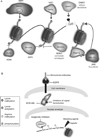Mechanisms of epigenetic regulation of leukemia onset and progression
- PMID: 23611284
- PMCID: PMC3830954
- DOI: 10.1016/B978-0-12-410524-9.00001-3
Mechanisms of epigenetic regulation of leukemia onset and progression
Abstract
Over the past decade, it has become clear that both genetics and epigenetics play pivotal roles in cancer onset and progression. The importance of epigenetic regulation in proper maintenance of cellular state is highlighted by the frequent mutation of chromatin modulating factors across cancer subtypes. Identification of these mutations has created an interest in designing drugs that target enzymes involved in DNA methylation and posttranslational modification of histones. In this review, we discuss recurrent genetic alterations to epigenetic modulators in both myeloid and lymphoid leukemias. Furthermore, we review how these perturbations contribute to leukemogenesis and impact disease outcome and treatment efficacy. Finally, we discuss how the recent advances in our understanding of chromatin biology may impact treatment of leukemia.
Copyright © 2013 Elsevier Inc. All rights reserved.
Figures



References
-
- Aifantis I, Raetz E, Buonamici S. Molecular pathogenesis of T-cell leukaemia and lymphoma. Nature Reviews. Immunology. 2008;8:380–390. - PubMed
Publication types
MeSH terms
Substances
Grants and funding
- T32 CA009161/CA/NCI NIH HHS/United States
- R01 CA133379/CA/NCI NIH HHS/United States
- R01CA133379/CA/NCI NIH HHS/United States
- R21CA141399/CA/NCI NIH HHS/United States
- R01 CA149655/CA/NCI NIH HHS/United States
- R01 CA105129/CA/NCI NIH HHS/United States
- HHMI/Howard Hughes Medical Institute/United States
- R01GM088847/GM/NIGMS NIH HHS/United States
- R21 CA141399/CA/NCI NIH HHS/United States
- R01CA149655/CA/NCI NIH HHS/United States
- R01CA105129/CA/NCI NIH HHS/United States
- R01 GM088847/GM/NIGMS NIH HHS/United States
LinkOut - more resources
Full Text Sources
Other Literature Sources
Medical
Miscellaneous

